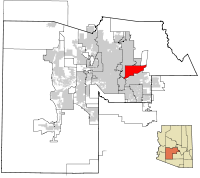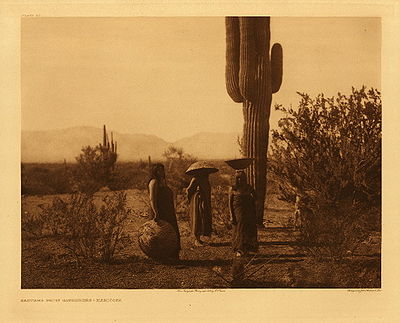
Salt River Pima-Maricopa Indian Community
Encyclopedia


Native Americans in the United States
Native Americans in the United States are the indigenous peoples in North America within the boundaries of the present-day continental United States, parts of Alaska, and the island state of Hawaii. They are composed of numerous, distinct tribes, states, and ethnic groups, many of which survive as...
tribes—the Pima
Pima
The Pima are a group of American Indians living in an area consisting of what is now central and southern Arizona. The long name, "Akimel O'odham", means "river people". They are closely related to the Tohono O'odham and the Hia C-ed O'odham...
(Akimel O'odham) and the Maricopa (Piipaash)—many of whom were originally of the Halchidhoma
Halchidhoma
The Halchidhoma are an Indian tribe now living mostly on the Salt River reservation, but formerly native to the area along the lower Colorado River in California and Arizona when first contacted by Europeans...
(Xalchidom) tribe. The community was officially created by an Executive Order of US President Rutherford B. Hayes
Rutherford B. Hayes
Rutherford Birchard Hayes was the 19th President of the United States . As president, he oversaw the end of Reconstruction and the United States' entry into the Second Industrial Revolution...
on June 14, 1879. The community area includes 53600 acres (216.9 km²) of which 19,000 remain a natural preserve. Today they are a federally recognized tribe located in Arizona
Arizona
Arizona ; is a state located in the southwestern region of the United States. It is also part of the western United States and the mountain west. The capital and largest city is Phoenix...
.
The community borders the Arizona
Arizona
Arizona ; is a state located in the southwestern region of the United States. It is also part of the western United States and the mountain west. The capital and largest city is Phoenix...
cities of Scottsdale
Scottsdale, Arizona
Scottsdale is a city in the eastern part of Maricopa County, Arizona, United States, adjacent to Phoenix. According to the U.S. Census Bureau, as of 2010 the population of the city was 217,385...
, Mesa
Mesa, Arizona
According to the 2010 Census, the racial composition of Mesa was as follows:* White: 77.1% * Hispanic or Latino : 26.54%* Black or African American: 3.5%* Two or more races: 3.4%* Native American: 2.4%...
, and Fountain Hills.
The Great Seal of the Salt River Pima–Maricopa Indian Community is a representation of I'itoi
I'itoi
Iʼitoi or Iʼithi is, in the tradition of the O'odham people, the mischievous creator god who resides in a cave just below the peak of Baboquivari Mountain, part of the Tohono O'odham Nation. Visitors to the cave are asked to bring a gift to ensure their safe return from the depths...
, commonly referred to as the Man in the Maze.
Business enterprises
The community operates two casinoCasino
In modern English, a casino is a facility which houses and accommodates certain types of gambling activities. Casinos are most commonly built near or combined with hotels, restaurants, retail shopping, cruise ships or other tourist attractions...
s on its land, both operating under the "Casino Arizona" brand name; the facilities attract gamblers from the local Phoenix area as well as out-of-state tourists. There is also a limited amount of office development, and a major outdoor shopping center The Scottsdale Pavilions (featuring national retailers such as Target, Bath & Body Works
Bath & Body Works
Bath & Body Works, LLC, is an American retail store under the Limited Brands umbrella. It was founded in 1990 in New Albany, Ohio and has since expanded across the United States and Canada. It specializes in lotions, bath items, personal care items, and home fragrances.The company launched both a...
, Home Depot, and Chipotle
Chipotle Mexican Grill
Chipotle Mexican Grill, Inc. is a chain of restaurants in the United States, United Kingdom, and Canada specializing in burritos and tacos, founded by Steve Ells in 1993 and based in Denver, Colorado...
), on the portions of tribal land closest to the northern business and financial districts of neighboring Scottsdale.
In February of 2011, the community opened Salt River Fields at Talking Stick, the first Major League Baseball spring training facility to be built on Indian land in the nation. This 140 acre baseball complex is the spring training home of the Arizona Diamondbacks
Arizona Diamondbacks
The Arizona Diamondbacks are a professional baseball team based in Phoenix. They play in the West Division of Major League Baseball's National League. From 1998 to the present, they have played in Chase Field...
and Colorado Rockies
Colorado Rockies
The Colorado Rockies are a Major League Baseball team based in Denver, Colorado. Established in 1991, they started play in 1993 and are in the West Division of the National League. The team is named after the Rocky Mountains...
.
Language
The Salt River Pima-Maricopa Indian Community supports the preservation of the Akimel O’odhamO'odham language
O'odham is an Uto-Aztecan language of southern Arizona and northern Sonora where the Tohono O'odham and Pima reside. As of the year 2000, there were estimated to be approximately 9750 speakers in the United States and Mexico combined, although there may be more due to underreporting...
and Xalchidom Piipaash
Maricopa language
The Maricopa language is spoken by the Native American Maricopa tribe, on two reservations in Arizona: the Salt River Pima-Maricopa Indian Community and the Gila River Indian Community.-Grammar:...
languages through teaching and learning for everyone within the Community and encourages all Community members to preserve the Akimel O’odham and Xalchidom Piipaash languages within their homes (Council Resolution SR-2026-2000).
Some tribal employees who work within the community take language classes so they have a better understanding of the community and people and have a better working relationship with the people they serve. When children are no longer learning a language, that language is in serious trouble. Some learners want to fill that void in their experience of their own culture and they want to know more about who they are. Some want to learn so they can understand whether their aunts or parents are talking about them.
Extreme poverty, school dropout, drug use, and border issues hinder the progress of language revitalization as the resolution of these issues appears more important to tribal members. After all, the needs of the tribe must be met as problems are prioritized. The effort and extent of revitalization makes it more difficult to put before other issues. Language activists are looking to reverse the language endangerment in their community but a commitment to the goal is needed for them to continue.
Man in the Maze
Central to the beliefs of the Salt River Pima-Maricopa Indian Community is the story of the Man in the Maze, or I'itoi ki:k, which is the symbol seen on the great seal. This ancient pattern visible at the right is representative of the journey a person makes through life, including obstacles and problems. The figure is called Elder Brother and he is about to make his way through the maze where at the center, he will find the Sun God who is there to greet him and bless him into the next world. The symbol belongs to the Akimel O’odham (Pima)Pima
The Pima are a group of American Indians living in an area consisting of what is now central and southern Arizona. The long name, "Akimel O'odham", means "river people". They are closely related to the Tohono O'odham and the Hia C-ed O'odham...
, Pee-Posh (Maricopa), and Tohono O'odham
Tohono O'odham
The Tohono O'odham are a group of Native American people who reside primarily in the Sonoran Desert of the southeastern Arizona and northwest Mexico...
tribes and is traditionally represented in petroglyph
Petroglyph
Petroglyphs are pictogram and logogram images created by removing part of a rock surface by incising, picking, carving, and abrading. Outside North America, scholars often use terms such as "carving", "engraving", or other descriptions of the technique to refer to such images...
s and basket designs.

